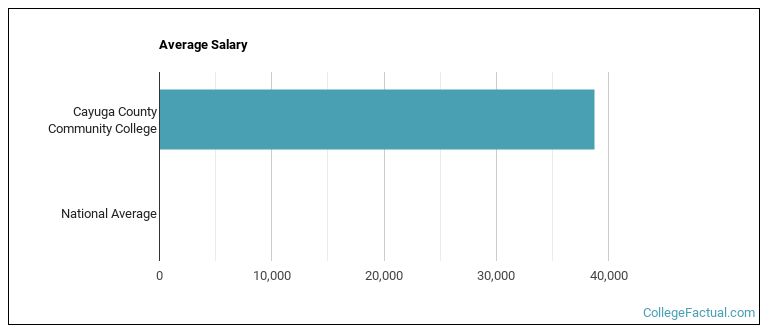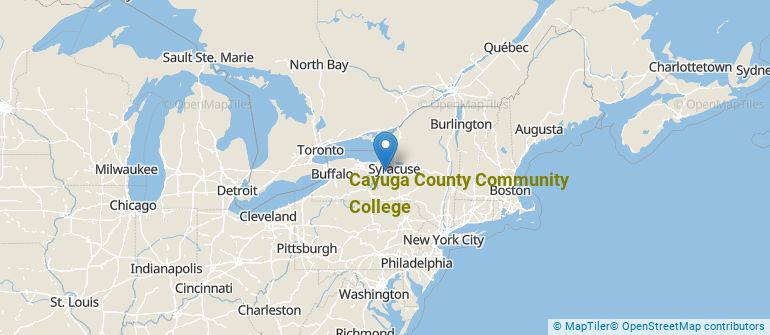 by our College Data Analytics Team
by our College Data Analytics TeamExplore the best ranked schools for the programs you are most interested in.
Cayuga Community College was not ranked in College Factual's 2025 Best Overall Colleges report. This could be for a number of reasons, including lack of data.
See all of the rankings for Cayuga County Community College.
If you are worried about getting into Cayuga County Community College, don't be. The school has a liberal open admissions policy, which means you only need to meet basic requirements in order to be admitted. Still, be sure to submit a complete application and provide any other requested materials.
The student to faculty ratio at Cayuga County Community College is 22 to 1, which is high when compared to the national average of 15 to 1. This may indicate that some of your classes will be larger in size than they would be at other schools. However, upper level classes will probably be smaller.
Another measure that is often used to estimate how much access students will have to their professors is how many faculty members are full-time. The idea here is that part-time faculty tend to spend less time on campus, so they may not be as available to students as full-timers.
The full-time faculty percentage at Cayuga County Community College is 33%. This is lower than the national average of 47%.
The freshmen retention rate of 49% tells us that most first-year, full-time students don't stick around for a second year at Cayuga County Community College. Students may have a variety of reasons for this, such as only intending to attend a school for one year while they brush up on certain subjects.
During the 2017-2018 academic year, there were 2,906 undergraduates at Cayuga Community College with 1,006 being full-time and 1,900 being part-time.
| $0-30 K | $30K-48K | $48-75 | $75-110K | $110K + |
|---|---|---|---|---|
| $4,639 | $6,121 | $9,609 | $11,444 | $12,915 |
The net price is calculated by adding tuition, room, board and other costs and subtracting financial aid.Note that the net price is typically less than the published for a school. For more information on the sticker price of Cayuga Community College, see our tuition and fees and room and board pages.
It's not uncommon for college students to take out loans to pay for school. In fact, almost 66% of students nationwide depend at least partially on loans. At Cayuga Community College, approximately 42% of students took out student loans averaging $5,226 a year. That adds up to $20,904 over four years for those students.
Get more details about paying for Cayuga County Community College.

See which majors at Cayuga County Community College make the most money.
Get more details about the location of Cayuga County Community College.

Contact details for Cayuga Community College are given below.
| Contact Details | |
|---|---|
| Address: | 197 Franklin Street, Auburn, NY 13021-3099 |
| Phone: | 315-255-1743 |
| Website: | https://www.cayuga-cc.edu/ |
| Most Popular Majors | Bachelor’s Degrees | Average Salary of Graduates |
|---|---|---|
| Liberal Arts General Studies | 139 | NA |
| Business Administration & Management | 46 | NA |
| Nursing | 29 | NA |
| Health Sciences & Services | 24 | NA |
| Criminal Justice & Corrections | 21 | NA |
| Allied Health & Medical Assisting Services | 11 | NA |
| Audiovisual Communications | 9 | NA |
| Mechanical Engineering Technology | 7 | NA |
| Electronics Engineering Technology | 5 | NA |
| Natural Resources Conservation | 5 | NA |
Online learning is becoming popular at even the oldest colleges and universities in the United States. Not only are online classes great for returning adults with busy schedules, they are also frequented by a growing number of traditional students.
In 2022-2023, 1,121 students took at least one online class at Cayuga County Community College. This is a decrease from the 1,350 students who took online classes the previous year.
| Year | Took at Least One Online Class | Took All Classes Online |
|---|---|---|
| 2022-2023 | 1,121 | 698 |
| 2021-2022 | 1,350 | 800 |
| 2020-2021 | 1,677 | 1,270 |
| 2018-2019 | 1,317 | 689 |
Learn more about online learning at Cayuga County Community College.
Footnotes
*The racial-ethnic minorities count is calculated by taking the total number of students and subtracting white students, international students, and students whose race/ethnicity was unknown. This number is then divided by the total number of students at the school to obtain the racial-ethnic minorities percentage.
References
More about our data sources and methodologies.